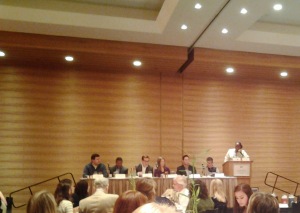Excited to be a part of today’s @BusinessWire “Meet the media” panel with: @ojezap @DPDREW @nlebens @mspbjHammer pic.twitter.com/ljwncVsUul
— Dave Schwartz (@Dave_Schwartz) October 9, 2014
Journalists in Minneapolis/St. Paul are in the midst of a “new paradigm for news generation,” and a few of them recently shared what that means for public relations professionals.
A panel event sponsored by the Minnesota chapter of Public Relations Society of America, Business Wire and the Twin Cities chapter of National Investor Relations Institute included:
- Dave Schwartz, sports reporter at KARE 11,
- Jim Hammerand, digital editor at the Minneapolis/St. Paul Business Journal,
- Julio Ojeda-Zapata, technology writer at the St. Paul Pioneer Press,
- Andy Putz, executive editor of MinnPost,
- Duchesne Drew, managing editor for operations at the Star Tribune, and
- Nancy Lebens, editor for MPR News.
According to panelists, social media, ever-tightening deadlines and media outlet collaboration are among the factors driving the changes.
For instance, Ojeda-Zapata recently was given access to the paper’s content management system. “That would have been unheard of before,” he said.
As could be expected, the digital aspect of media outlets is taking on increasing importance. Lebens shared that half of MPR News’ website traffic comes from mobile devices. Since switching to a digital-first strategy, the Minneapolis/St. Paul Business Journal audience has grown to 400,000.
Social media is an important tool to journalists in news gathering and keeping a pulse on possible stories.
“I use Twitter the way that people used to use a scanner,” said Lebens.
Ojeda-Zapata frequently uses Google+, and his blog provides an opportunity for content that doesn’t make the print edition of the paper.
To assist journalists in meeting their tight deadlines, panelists recommended that organizations have excellent newsrooms on their websites that make information easy for journalists to access. (NOTE: This article, write I co-wrote for TACTICS, addresses specifically what should be in an online pressroom.)
Panelists also shared some examples of the increasing collaboration of media outlets:
- KARE-TV works with MPR News to share stories.
- The Minneapolis/St. Paul Business Journal cooperates with KMSP-TV and WCCO Radio.
- This year the Star Tribune started printing the St. Paul Pioneer Press.
- Twin Cities TV stations use an overnight “pool shooter” that films breaking stories, and all stations share the resulting footage.
With all the changes, however, some aspects of collaborating with journalists are staying the same. E-mail is still the best way to connect. Relationships matter. Follow-up phone calls are OK. Some journalists are even up for informational coffees if their schedule allows.

